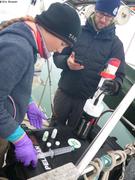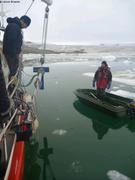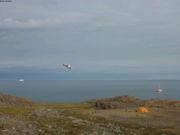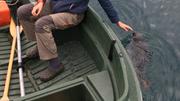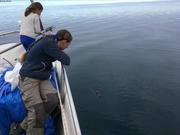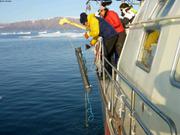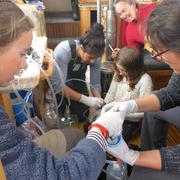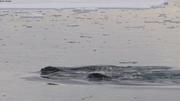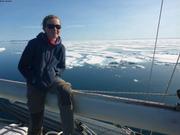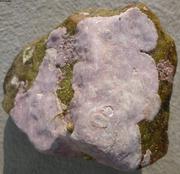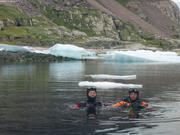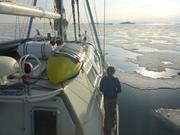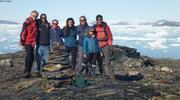Vagabond is sailing again, at last. The wind has stopped and it is time
to search for coralline again. The mission will end in 5 days and our
collect is rather small since Upernavik. This is where Jochen Halfar, in
charge of the scientific program, joined us for 17 days.
From Disko Bay to Upernavik, we didn't dive, we already explored this
area in 2016. Since Upernavik, with Jochen, the search is intense again,
the dives often fantastic, but relatively little red algae to sample...
Nevertheless, plates are easily filled up with scallops, mussels and sea
urchins!
Crossing Melville Bay is incredible. Sea ice is just breaking up, we
even get stuck for a while in the ice (a lot less than in 2011),
surrounded by numerous icebergs. Sun is shining night and day above a
glossy sea. Whales and polar bear are seen nearby. A few trips ashore
let us enjoy the immensity of this wild region of Greenland.
In Savissivik, remote village North-West of Melville Bay, down a big
little auks colony, we meet with Ole and his family again. They welcomed
us very warmly and gave us dogs in 2012. With 5 kids, they represent 15%
of the local community. Ole likes better hunting narwhal with his kayak
and seal skin float, rather than using his speed boat, which is allowed
since 2006. He gives us some skin (maqtaq), that can be eaten raw or
cooked. We give him the only scallop I found when diving this morning,
in front of his village. Local but unusual food for him! He is really
curious about our search for coralline, Jochen and Natasha are giving
him a little sample. We all have a shower at the community building,
then we sail towards Cape York.
Wind is pushing us to the North-West, a little bit too fast (up to 9
knots!) because conditions are getting too difficult to explore the
seafloor. The anchor in Parker Snow Bay doesn't hold, so Vagabond keeps
going at a good speed. No way to stop to Thule Air Base because wind is
taking us in the other direction. Around 6 in the morning, I drop anchor
in less than 2m depth, close to Fitz Clarence Rock (200m), in Booth Bay.
But early in the afternoon, 50 knots of wind is kicking us out from
anchorage: in very shallow water, engines running at high speed to avoid
being smashed on the rocky shore, Vagabond is trying her best to get to
a better shelter inside the same Booth Bay. No sea charts here, eyes are
constantly watching the radar and the sounder. What a relieve, after a
long fight, when the anchor is holding. It will even hold until the end
of the gale (4 days in total).
While we are not able to leave the boat because of the weather, Aurore
and Leonie, decorating the boat and cooking pastries, make sure everyone
is enjoying France Day, July 14th!
We already sailed more than 3000 nautical miles from Miquelon.
